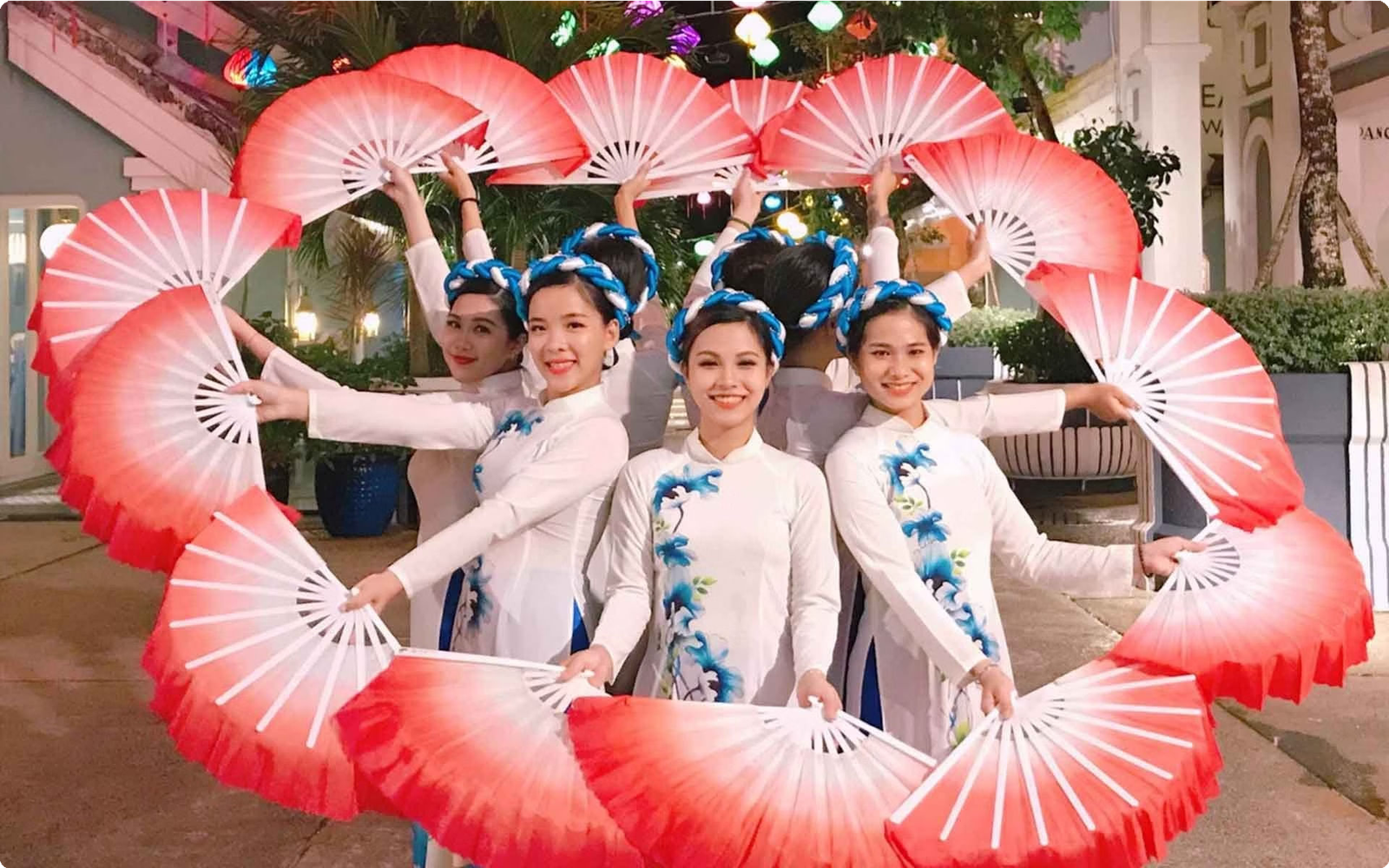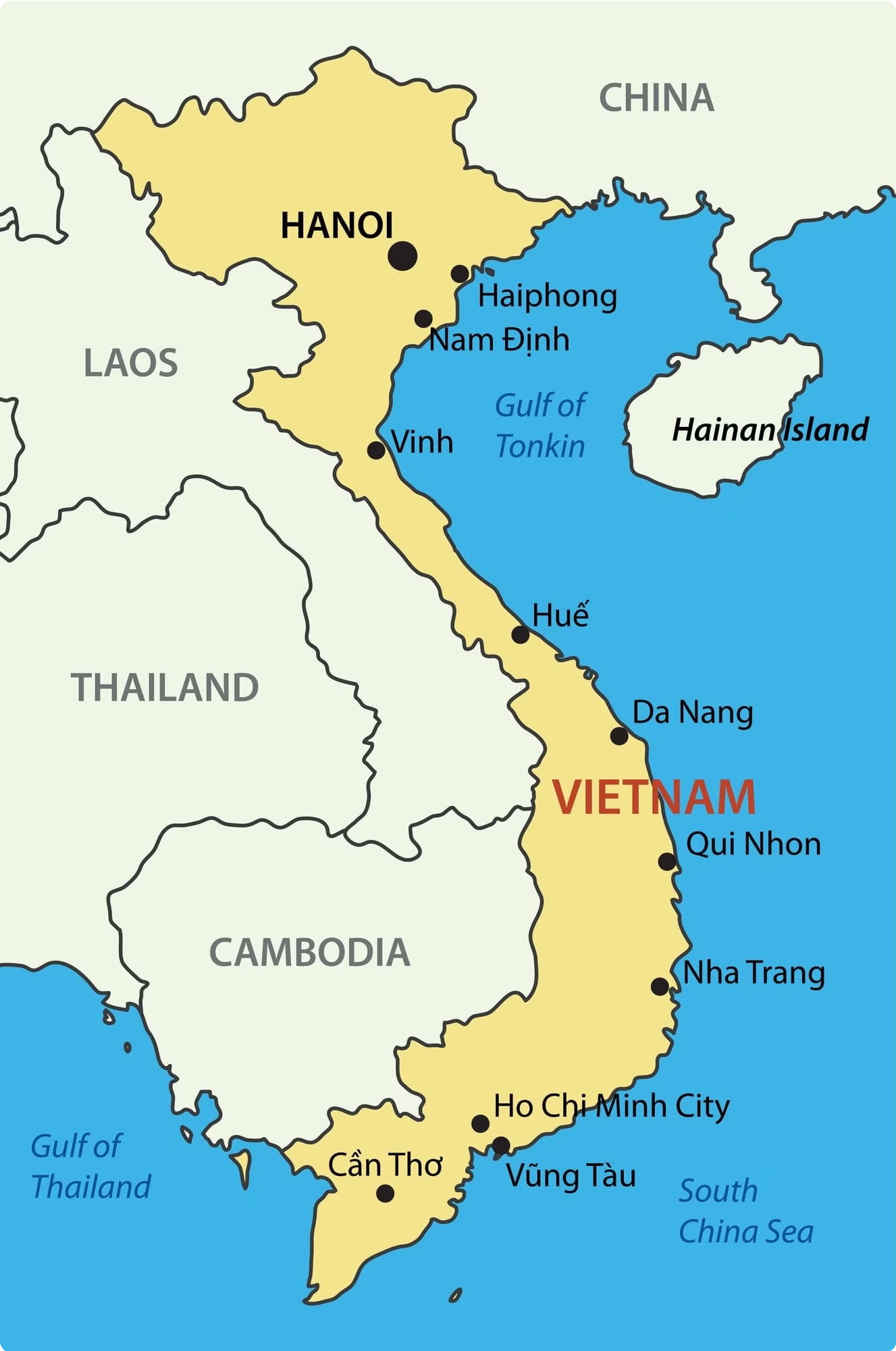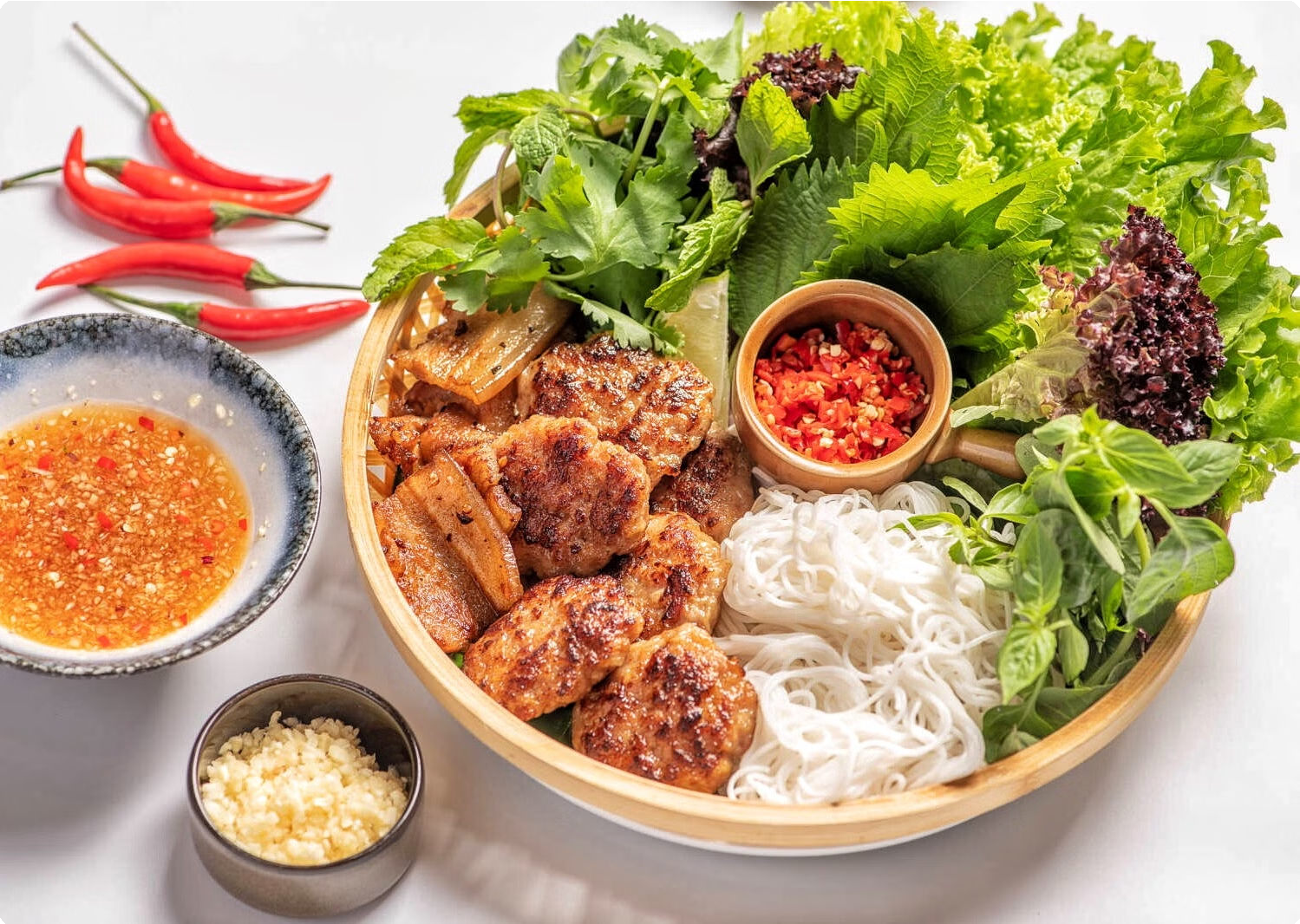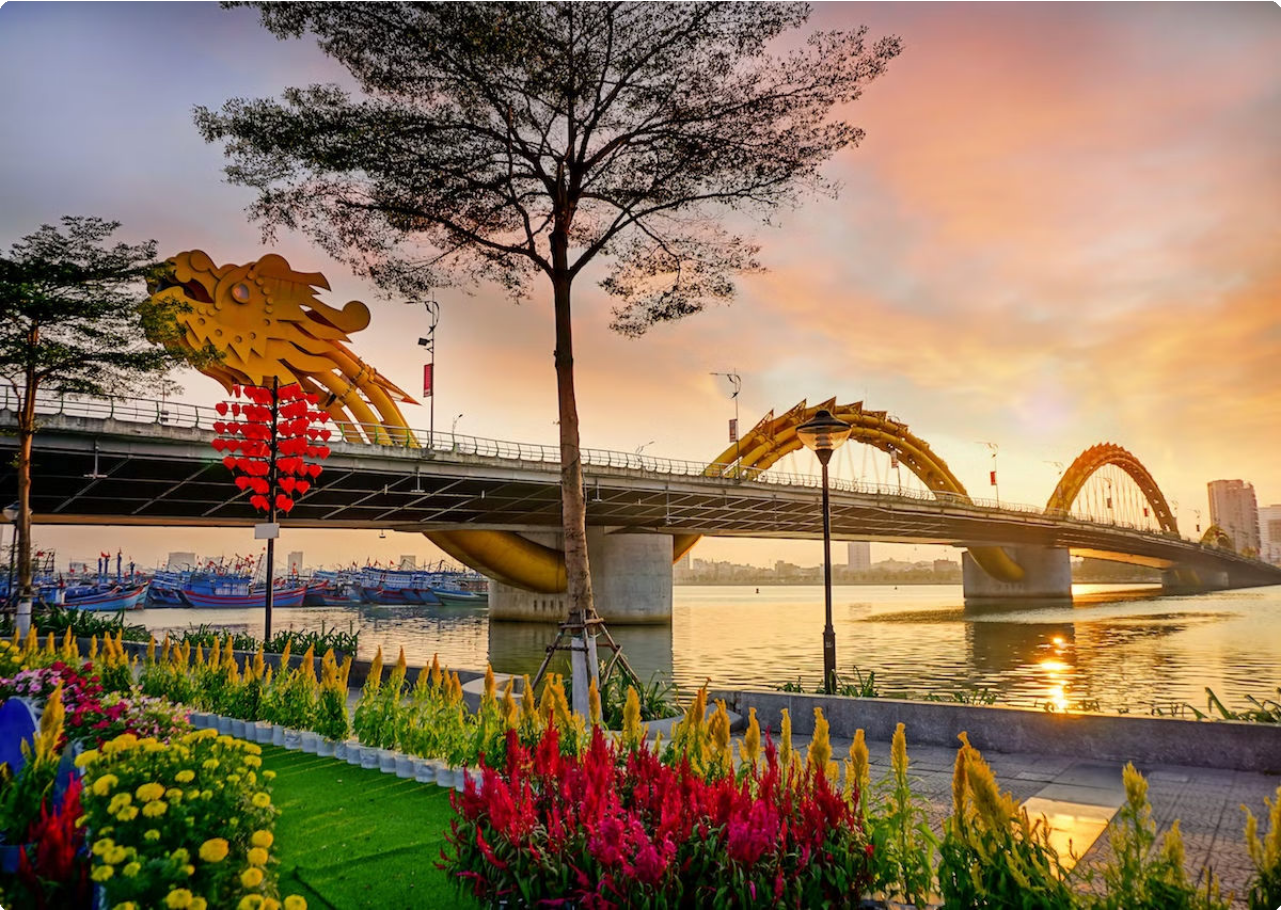Vietnam
Discover Vietnam: A Rich Tapestry of Culture and History
Vietnam, located in Southeast Asia, is a country known for its rich history, diverse culture, and breathtaking landscapes. From the bustling streets of Hanoi to the serene waters of Ha Long Bay, Vietnam offers a unique blend of tradition and modernity.

The country’s storied past, marked by dynasties, colonial rule, and independence movements, has left an indelible mark on its people and traditions. Vietnamese cuisine, with its bold flavors and fresh ingredients, is a testament to the country’s culinary prowess and cultural heritage.
With vibrant festivals, captivating traditional dances, and warm hospitality, Vietnam is a destination that leaves a lasting impression on all who visit.
The Flag of Vietnam
The flag of Vietnam, also known as the “red flag with a yellow star,” is a poignant symbol of the country’s rich history and resilience. The vibrant red background represents the revolutionary struggle for independence and the bloodshed of the Vietnamese people. The large yellow star at the center signifies the unity of the Vietnamese people and their aspirations for a bright future. Designed in 1940, the flag has evolved with the nation, reflecting Vietnam’s enduring spirit and pride. It serves as a powerful visual representation of Vietnam’s heritage and the values of freedom, solidarity, and determination.

Map of Vietnam
Vietnam, located in Southeast Asia, is known for its beautiful landscapes, rich history, and vibrant culture. The map of Vietnam showcases the diverse regions, from the mountainous north to the bustling cities in the south. The country is bordered by China to the north, Laos and Cambodia to the west, and the South China Sea to the east.

With its unique S-shaped geography, Vietnam offers a wide range of experiences, from the lush Mekong Delta to the stunning karst formations of Ha Long Bay. The map provides an overview of this fascinating country’s topography, highlighting key destinations and attractions that make Vietnam a must-visit destination for travelers.
Currency of Vietnam
Vietnamese Dong (VND)
The official currency of Vietnam is the Vietnamese Dong (VND). The currency symbol is ₫, and it is abbreviated as “đ” or “VND”. It is widely used for all transactions within the country.

Banknotes and Coins
The Vietnamese Dong is available in various denominations, including banknotes in 1000, 2000, 5000, 10,000, 20,000, 50,000, 100,000, 200,000, and 500,000 VND. There are also coins available for smaller denominations.
Exchange Rates
Exchange rates for the Vietnamese Dong fluctuate and can be checked at banks, foreign exchange counters, or online platforms. It’s important to stay updated on the current exchange rates when exchanging currency for travel or business purposes.
Economy of Vietnam
Growing Industries: Vietnam’s economy has been growing rapidly in recent years, with key industries including manufacturing, technology, and agriculture.
Exports and Trade: The country is known for exporting products such as textiles, electronics, and seafood, contributing significantly to its economic growth.
Foreign Investment: Vietnam has attracted substantial foreign investment, particularly in the manufacturing and service sectors, which has fueled its economic development.
Culture of Vietnam
Vietnamese culture is a rich tapestry of traditions, customs, and beliefs that have evolved over centuries. The influence of Confucianism, Buddhism, and Taoism is evident in various aspects of Vietnamese culture, from family structure to art and architecture. The tradition of ancestor worship is deeply rooted in Vietnamese society, with families paying homage to their ancestors through rituals and ceremonies.
The vibrant and colorful festivals of Vietnam, such as Tet (Lunar New Year) and Mid-Autumn Festival, showcase the unity and strong community spirit of the Vietnamese people. Traditional Vietnamese architecture, with its intricate designs and emphasis on harmony with nature, reflects the deep spiritual connection that the Vietnamese have with their surroundings.
The art of water puppetry, a unique Vietnamese tradition, continues to captivate audiences with its enchanting performances that depict rural life and folklore. Vietnamese cuisine, famous for its balance of flavors and fresh ingredients, is an integral part of the country’s culture, with communal dining and sharing at the heart of the dining experience.
Traditional Dances in Vietnam
Vietnamese traditional dances are an embodiment of the country’s rich cultural heritage and history. With graceful movements and vibrant costumes, these dances reflect the stories of Vietnam’s traditions and folklore.

One of the most famous traditional dances is the “Apsara Dance,” which is performed with elaborate costumes and intricate choreography, depicting ancient legends and rituals. Another captivating dance is the “Lion Dance,” symbolizing luck and fortune, often performed during festivals and celebrations.
Each region in Vietnam has its unique traditional dance forms, such as the “Hat Xoan” in the northern province of Phu Tho, and the “A Dao” dance of the central highlands, each carrying its distinct cultural significance.
Vietnamese Cuisine
Vietnamese cuisine is known for its fresh and flavorful dishes, often incorporating a variety of herbs, spices, and textures. The cuisine is heavily influenced by the country’s agricultural and coastal resources, resulting in a diverse array of dishes. Common ingredients include lemongrass, fish sauce, shrimp paste, and fresh herbs such as mint, cilantro, and Thai basil.
One of the most iconic Vietnamese dishes is pho, a fragrant soup with rice noodles, fresh herbs, and either beef or chicken. Other popular dishes include banh mi, a delicious baguette sandwich filled with a variety of meats and pickled vegetables, as well as fresh and crispy spring rolls called goi cuon.
Vietnamese cuisine also offers various regional specialties, such as the spicy and robust flavors of central Vietnamese dishes, or the delicate and subtle dishes of the north. Each region of Vietnam offers a unique culinary experience, showcasing the country’s rich food culture.
Famous Vietnamese Dishes
Pho
Pho is a traditional Vietnamese noodle soup consisting of broth, rice noodles, herbs, and meat, usually beef or chicken. It is a popular street food in Vietnam and has gained international recognition for its aromatic and flavorful qualities.

Bun Cha
Bun Cha is a dish originating from Hanoi, consisting of grilled fatty pork, served in a broth with rice noodles and a variety of herbs and fresh vegetables. It is known for its rich and savory flavors and is a must-try for visitors to Vietnam.

Banh Mi
Banh Mi is a Vietnamese sandwich with a French colonial influence, featuring a crusty baguette filled with various savory ingredients such as pate, pork, and fresh vegetables. It has become a beloved street food with a perfect balance of flavors and textures.

Goi Cuon
Goi Cuon, also known as Vietnamese fresh spring rolls, are a healthy and refreshing dish made with shrimp, herbs, vegetables, and vermicelli wrapped in rice paper. They are typically served with a flavorful dipping sauce and are a popular appetizer in Vietnamese cuisine.

Vietnamese Celebrities
Khoi My
Khoi My is a popular Vietnamese singer, actress, and model. She has gained fame for her versatile talents and captivating performances. Khoi My’s contribution to the Vietnamese entertainment industry has made her a beloved celebrity among fans.

MC Tran Thanh
MC Tran Thanh is a famous Vietnamese comedian and TV host. He is known for his witty humor and charismatic personality, which have made him a beloved figure in the Vietnamese entertainment industry.

SON TUNG M-TP
SON TUNG M-TP is a Vietnamese singer and songwriter. He has released many popular songs that have gained him a large following in Vietnam and around the world. His unique style and catchy tunes have made him one of the most influential musicians in Vietnam.

Best cities to travel in Vietnam
Hanoi: The capital city of Vietnam is a vibrant mix of ancient and modern architecture, with attractions such as the Old Quarter, Hoan Kiem Lake, and the Temple of Literature. Visitors can also enjoy the delicious street food and traditional water puppet shows.
Ho Chi Minh City: Formerly known as Saigon, this city is known for its rich history, French colonial landmarks, and bustling markets. The War Remnants Museum and Cu Chi Tunnels offer insight into Vietnam’s wartime history, while Ben Thanh Market and Notre-Dame Cathedral are popular tourist spots.
Da Nang: Located along the central coast of Vietnam, Da Nang is famous for its beautiful beaches, mountains, and vibrant cultural sites. The Ba Na Hills, Marble Mountains, and Dragon Bridge are among the must-see attractions.
Hoi An: This charming ancient town is known for its well-preserved architecture, lantern-lit streets, and picturesque riverside setting. Visitors can explore the historic Old Town, relax on An Bang Beach, and take part in lantern-making workshops.
Hue: As the former imperial capital of Vietnam, Hue is home to the UNESCO-listed Imperial City, royal tombs, and beautiful pagodas. The Perfume River adds a serene charm to the city, and visitors can explore the vibrant Dong Ba Market.
Hanoi
Hanoi, the capital of Vietnam, is known for its centuries-old architecture and a rich culture with Southeast Asian, Chinese, and French influences. The city is famous for its vibrant street markets, lush parks, and historic temples. One of the most iconic landmarks is the Hoan Kiem Lake, a picturesque body of water in the heart of the city.

The Old Quarter, with its narrow streets and traditional shophouses, offers a glimpse into the city’s past and is a paradise for food enthusiasts and history buffs. Additionally, Hanoi is home to the Temple of Literature, a well-preserved complex that was Vietnam’s first national university.
The city is a blend of modern and traditional, with bustling streets filled with scooters and a thriving cafe culture. Visitors can enjoy traditional Vietnamese coffee or sip on refreshing local beer while watching the city buzz by. Hanoi also boasts a thriving arts scene, with numerous galleries and theaters showcasing both traditional and contemporary Vietnamese art.
Ho Chi Minh City
Ho Chi Minh City, also known as Saigon, is the largest city in Vietnam, capturing the rush of modern life while retaining its historical charm. The city is a bustling metropolis with a vibrant street life, diverse architectural styles, and a rich cultural heritage.

The city’s skyline is a mix of contemporary skyscrapers and French colonial buildings, reflecting its complex history. Visitors can explore the War Remnants Museum, which provides insights into the Vietnam War, or marvel at the intricate architecture of the Notre Dame Cathedral and the Central Post Office.
Ho Chi Minh City is famous for its street food scene, offering an array of flavors and delicacies. From the bustling Ben Thanh Market to the serene Saigon River, the city offers an immersive experience that combines tradition, modernity, and Vietnamese hospitality.
Da Nang
Da Nang is a coastal city in central Vietnam known for its beautiful sandy beaches, stunning marble mountains, and rich history. It is a popular destination for both locals and tourists, offering a perfect blend of natural beauty, cultural attractions, and modern amenities.

The city’s most famous landmark is the Dragon Bridge, an impressive architectural marvel that breathes fire and spouts water on weekends. Visitors can also explore the vibrant Han Market, which offers an array of local produce, handicrafts, and souvenirs.
For those interested in history and spirituality, the Marble Mountains are a must-visit, featuring ancient Buddhist pagodas and mesmerizing limestone caves. Da Nang is also home to unique museums, such as the Museum of Cham Sculpture, showcasing a remarkable collection of Cham artifacts and sculptures.
With its mix of natural wonders, cultural sites, and modern attractions, Da Nang is a city that offers something for everyone, whether seeking relaxation on the beach or immersing in the rich heritage of Vietnam.
Hoi An
Hoi An, a well-preserved ancient town in Vietnam’s Quang Nam Province, is a UNESCO World Heritage site known for its exceptionally well-preserved architecture, diverse culture, and charming atmosphere. This town served as a significant Southeast Asian trading port from the 15th to the 19th century, and its architecture reflects a unique blend of indigenous and foreign influences.

Hoi An is famous for its lantern-lit streets, colorful buildings, and riverside views, making it a picturesque destination for travelers seeking to immerse themselves in Vietnam’s rich history and culture. The town is also renowned for its skilled tailors, traditional handicrafts, and delectable local cuisine, offering visitors an authentic Vietnamese experience.
Visitors to Hoi An can explore its historic old town, visit the Japanese Covered Bridge, stroll along the Thu Bon River, and engage in traditional activities such as lantern making and Vietnamese cooking classes. The town’s vibrant markets, art galleries, and cultural festivals further add to its allure, making it a must-visit destination for anyone exploring Vietnam.
Hue
Hue is a city in central Vietnam that was the national capital from 1802 to 1945. The city is known for its rich history, ancient architecture, and vibrant culture. One of the most significant landmarks in Hue is the Imperial City, a UNESCO World Heritage site that served as the political and cultural center of the Nguyen Dynasty. The Perfume River, which flows through the city, adds to the picturesque setting of the area, providing a serene and tranquil atmosphere.
The cuisine of Hue is renowned for its royal legacy, with dishes that are both visually stunning and delicious. Visitors can explore the traditional markets, where vendors offer a wide array of local specialties, including the famous Hue beef noodles. Additionally, the city’s traditional music and
performing arts, such as the Royal Court Music and Hue Festival, showcase the artistic richness of the region.
Hue’s diverse landscape also offers opportunities for outdoor activities, with the nearby countryside dotted with ancient pagodas, royal tombs, and natural wonders. The city’s charm, historical significance, and unique cultural heritage make it a must-visit destination for travelers seeking an authentic Vietnamese experience.
Nha Trang
Nha Trang is a coastal city located in the southern part of Vietnam, renowned for its beautiful beaches and rich cultural heritage. The city is a popular tourist destination, offering a perfect blend of traditional Vietnamese culture and modern amenities. Nha Trang is known for its pristine sandy beaches, crystal- clear waters, and vibrant nightlife, making it an ideal location for beach enthusiasts and partygoers alike.
The city also boasts a range of historical and cultural attractions, including ancient temples, bustling markets, and serene pagodas. Nha Trang’s culinary scene is diverse, offering an array of fresh seafood delicacies and traditional Vietnamese dishes.
For those seeking adventure, Nha Trang provides opportunities for water sports, snorkeling, and island- hopping, allowing visitors to explore the picturesque islands and marine life of the region. The warm and tropical climate of Nha Trang makes it an appealing destination throughout the year, attracting travelers from around the world.
Sapa
Sapa is a charming highland town located in northern Vietnam, known for its stunning terraced rice fields, vibrant ethnic minority communities, and breathtaking mountain landscapes. The town offers a peaceful escape from the hustle and bustle of city life, with its cool climate and picturesque surroundings. Visitors to Sapa can embark on memorable treks through the lush countryside, immersing themselves in the natural beauty and rich cultural heritage of the region.
The town is also home to authentic markets where local villagers trade their goods, providing an opportunity for visitors to experience the unique traditions and craftsmanship of the ethnic communities. Sapa’s traditional cuisine, infused with fresh ingredients and distinctive flavors, offers a delightful culinary experience for travelers.
The majestic Fansipan, the highest peak in Indochina, towers over Sapa, offering adventurers the chance to conquer its summit through guided trekking expeditions. Sapa truly captivates the hearts of those seeking an enriching blend of natural wonders, cultural diversity, and outdoor exploration.
Halong Bay
Halong Bay is a UNESCO World Heritage Site located in northeastern Vietnam. It is known for its stunning seascape of limestone pillars and islets, as well as its emerald waters. The bay encompasses an area of over 1,500 square kilometers and includes around 2,000 limestone formations, many of which are topped with lush vegetation. Visitors to Halong Bay can explore the surreal landscape by taking a cruise on traditional wooden boats, enjoying activities such as kayaking, swimming, and visiting the floating fishing villages. The bay is also home to numerous caves and grottos, adding to the mystical and enchanting atmosphere of this natural wonder.

Mekong Delta
The Mekong Delta, located in southwestern Vietnam, is a lush and vibrant region formed by the Mekong River as it approaches the South China Sea. Known as the “Rice Bowl” of Vietnam, the delta is famous for its fertile soil, abundant rice paddies, and intricate network of waterways. The picturesque landscape is adorned with verdant rice fields, coconut palms, and charming floating markets where locals trade goods from their boats.

This region is home to a diverse community of ethnic groups, each with its own customs and traditions. Visitors can experience the unique culture of the delta through homestays, boat trips, and interactions with local craftsmen and artisans. The Mekong Delta offers a serene and enchanting escape, providing insight into the everyday life of the Vietnamese people in a stunning natural setting.
Phu Quoc Island
Phu Quoc is a stunning tropical paradise located in the Gulf of Thailand, known for its pristine white-sand beaches, crystal-clear waters, and lush greenery. The island is a popular destination for beach lovers, nature enthusiasts, and adventure seekers.

Visitors can indulge in a range of activities, from snorkeling and scuba diving along vibrant coral reefs to exploring dense, jungle-covered hills. The island’s fishing villages offer a glimpse into local life, while the night markets and seafood restaurants provide delicious culinary experiences.
Phu Quoc is also home to Phu Quoc National Park, a haven for biodiversity with diverse flora and fauna. The laid-back atmosphere, coupled with breathtaking sunsets and starry nights, makes Phu Quoc a must-visit destination for those seeking tranquility amidst natural beauty.
Places to visit in Vietnam
Ha Long Bay: Known for its emerald waters and thousands of towering limestone islands topped with rainforests, Ha Long Bay is a UNESCO World Heritage site and a must-see destination in Vietnam.
Visitors can explore the caves, go kayaking, or take a boat cruise to admire this breathtaking natural wonder.
Hoi An Ancient Town: A charming historical town with well-preserved architecture, lantern-lit streets, and a rich blend of Vietnamese, Chinese, and Japanese influences. It’s famous for its tailor shops, local markets, and delectable street food, making it a paradise for culture and food lovers.
Cu Chi Tunnels: Offering a glimpse into Vietnam’s wartime history, the Cu Chi Tunnels are an impressive network of underground tunnels that served as a strategic base for the Viet Cong during the Vietnam War. Visitors can crawl through the narrow passages and learn about the resilience and resourcefulness of the Vietnamese fighters.
Phong Nha-Ke Bang National Park: Home to the world’s largest cave systems and a diverse ecosystem, this national park is a paradise for adventure seekers and nature enthusiasts. Visitors can explore the stunning limestone karsts, hike through lush jungle trails, and embark on thrilling underground expeditions.
Ha Long Bay
Ha Long Bay, located in northeastern Vietnam, is renowned for its emerald waters and thousands of towering limestone islands topped with rainforests. This UNESCO World Heritage site is a breathtaking natural wonder, offering visitors stunning panoramic views and unique experiences. The bay’s calm waters make it ideal for cruising, kayaking, and exploring hidden caves and grottoes.

Visitors to Ha Long Bay can enjoy activities such as swimming, snorkeling, and even overnight stays on traditional wooden boats known as “junk boats”. The bay’s mystical landscapes create a serene and enchanting atmosphere, often shrouded in mist and magical light.
Hoi An Ancient Town
Hoi An Ancient Town is a well-preserved example of a Southeast Asian trading port dating from the 15th to the 19th century. Its buildings and street plan reflect a blend of indigenous and foreign influences. The town is renowned for its charming, well-preserved architecture, lantern-lit streets, and vibrant riverside markets. Visitors can explore the historic district, which is a UNESCO World Heritage site, and wander through its narrow lanes lined with old buildings and shops. The town also offers traditional Vietnamese cultural experiences, such as tailor shops, handicraft artisans, and delicious local cuisine.

Hoi An Ancient Town represents a fusion of indigenous and foreign traditions, making it an exceptional example of an ancient port town. The town’s unique architecture, local traditions, and historical significance make it a must-visit destination for travelers seeking to immerse themselves in Vietnam’s rich cultural heritage.
Cu Chi Tunnels
The Cu Chi Tunnels are an elaborate underground network located in Cu Chi, near Ho Chi Minh City, Vietnam. These tunnels played a vital role during the Vietnam War, serving as a base for the Viet Cong guerilla fighters. The tunnels are an astonishing feat of engineering, comprising a complex network of narrow passages, trapdoors, bunkers, and underground chambers.

Visitors to the Cu Chi Tunnels today can explore a section of the tunnel system, gaining a firsthand experience of the harsh conditions endured by the soldiers who lived and fought underground. The site also features exhibits and displays showcasing the innovative tactics used by the Viet Cong and the resilience of the Vietnamese people during the war.
Phong Nha-Ke Bang National Park
Phong Nha-Ke Bang National Park is a UNESCO World Heritage site located in the Quang Binh Province of central Vietnam. It is renowned for its stunning limestone karst landscapes adorned with underground rivers, caves, and grottoes. The park is home to the oldest karst mountains in Asia, with an impressive system of over 300 caves and underground rivers.

The most famous cave within the park is Son Doong Cave, considered the largest cave passage in the world. Visitors to the park can explore the breathtaking beauty of Paradise Cave, Phong Nha Cave, and other intricate underground formations. The park also boasts lush forests, wildlife, and diverse ecosystems, making it a haven for nature enthusiasts and adventurers.
Phong Nha-Ke Bang National Park offers opportunities for trekking, caving, and exploring unique geological wonders, providing an unforgettable experience for anyone who appreciates natural beauty and wonders.
Conclusion
After exploring the diverse and vibrant aspects of Vietnam, it’s clear that this country is a treasure trove of culture, history, and natural beauty. From the bustling metropolis of Ho Chi Minh City to the serene waters of Ha Long Bay, Vietnam offers an unforgettable experience for travelers. The rich tapestry of traditional dances, mouthwatering cuisine, and warm hospitality makes Vietnam a must-visit destination for anyone seeking a truly immersive travel experience.

With its fascinating history, breathtaking landscapes, and welcoming locals, Vietnam has something to offer for every type of traveler. Whether you’re drawn to the bustling city life or the tranquil countryside, Vietnam is a destination that will leave a lasting impression. As you plan your next adventure, consider the enchanting allure of Vietnam and the countless memories waiting to be made in this captivating country.